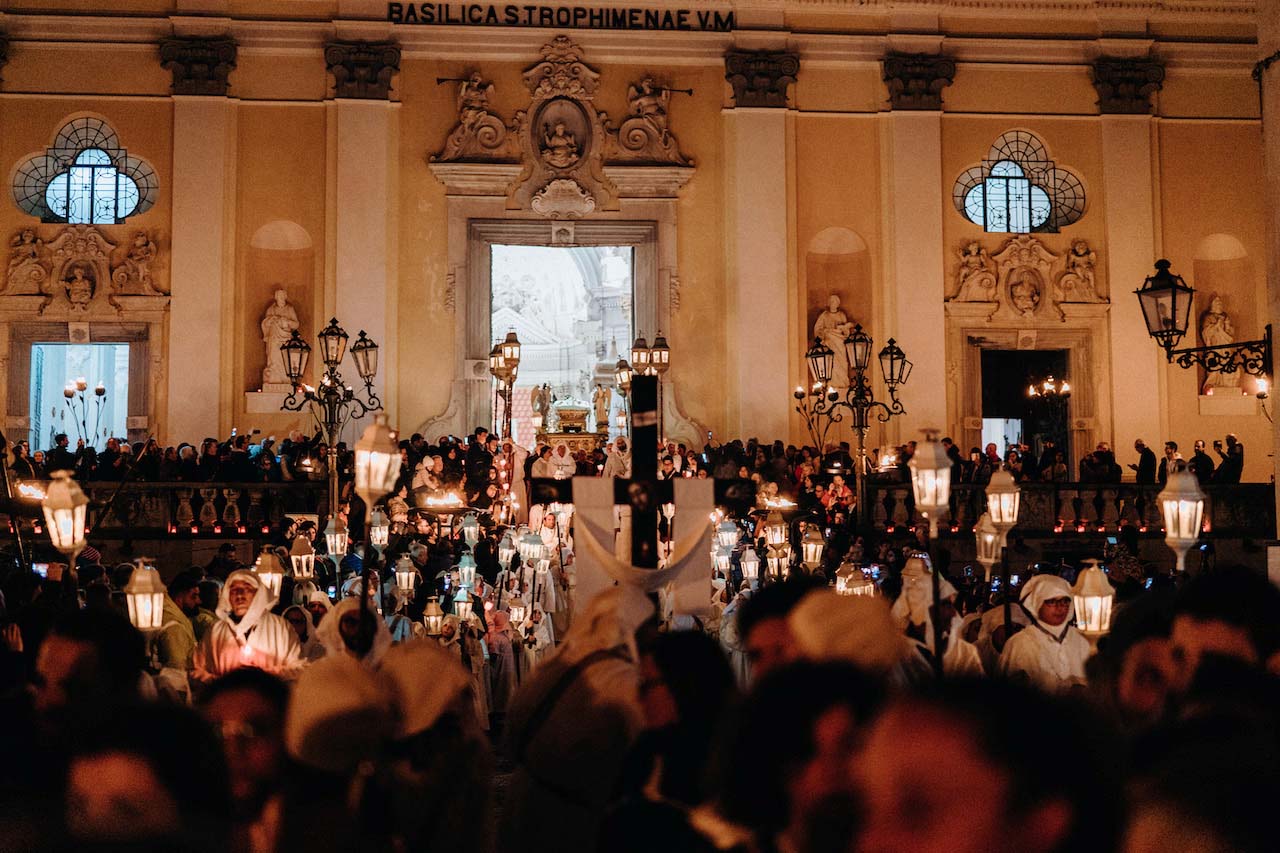The Battenti are salient figures of Easter on the Amalfi Coast. Their songs are prayers and sounds that have become part of the local cultural heritage.
March 24th, 2024. By Francesca Faratro, photo by Giuseppe Proto
“The Heavenly Father puts it in our blood!” Amalfi’s elders say, letting them fully perceive the value of their role. The Battenti, the hooded men clad in white cassocks, are salient figures of Easter on the Amalfi Coast, and their songs are prayers and sound that rise to the heavens, consigned to history becoming tradition.
Also known as hooded sinners, they fill the streets day and night, marking the rites of Holy Week. With their centuries-old chants, they fill alleys and streets, widenings and squares, following a specific calendar that stops in the churches of coastal towns, respecting the same ritual each year.
The beginning and significance of the route
Their origin, poorly defined and coupled with the Easter religious traditions of much of the Campania region, is associated with the covens that carry on the tradition and diversify among themselves. Each coven differs from the other not only in the repertoire offered but also in the color of the tonic or some detail that characterizes the members’ dress.
“To be a Baptist means to possess an innate love for the role and, above all, to be animated by the desire to transmit it to young people so they can participate not only as spectators. In time they will be the ones to continue the tradition so that it will never die,” says Luigi Aceto, a young man from Minori who has been Battente since childhood. “Every man has to be Battente to live the ‘experience of faith, identify with it and get sentimentally involved in the memory of the Passion of Christ through the ancient culture and the suggestiveness proper to the place. Only in this way will they continue in time to be, with their songs, bearers of love.”

Amalfi Coast tradition
On the Amalfi Coast, the first appearances of the Battenti date back to the 14th century when they, dressed in white and girded with hemp rope, walked the streets of Minori. Singing without accompanying instruments but solely with their voices, they composed an ensemble of unique notes and tones.
The Battenti of Amalfi, on the other hand, are those who silently accompany Jesus Christ and die in the procession. Their golden candles create for the narrow streets of the seaside village an evocative setting between dull lights and areas of shadow.
The ritual, as seen in Gomorrah 2
The Minori tradition, between the sacred and the profane, has also been the protagonist of several films: numerous directors have proposed the beauty of such figures for their film scripts. Most recently, the appearance of the Battenti in the series Gomorra 2, especially in the episode depicting the procession of the dead Jesus Christ among the city streets.

From father to son
Wearing a pointed hood, the repertoire is performed by men only, and the songs are handed down solely from father to son. Of the origin of the texts, there are no witnesses, but recent studies date them to the Baroque period. The songs are based on indigenous texts that refer to the last hours of the Lord’s life and his Passion. Divided into fourteen stations, each piece consists of two stanzas. The only significant distinction is in the performance of these: some are performed in the streets, others solely inside churches.
The presence of children
Also, the children entrusted with the most crucial role are part of the groups. After performing the repertoire, it will be the youngest child’s turn to conclude with specific stanzas. Only then can the moment end and then move on to the next stage of the journey. For the little ones, such a ritual knows neither toil nor effort; they quiver to go out at night, in the shadow of candles, even if it takes them out of sleep.

Voices and voices
Within the group, there are salient differences to be respected and different shades of voices: the lowest ones are part of the voci e vascie, while the high ones are those e’ ncoppe. This distinction is not the result of chance but has a precise location entrusted to the history and origins of the purely Minori tradition.
In ancient times Minori, two congregations were assigned to harmonize the songs of Holy Week. On Thursday evening, it was the turn of the Archconfraternity of the Blessed Sacrament, ready to begin the rites of Christ’s death and passion with the Ton’ e vascie. This appellation referred not only to the tonality of the voice during the performance but also to the location of the congregation, located at the lowest point of the village.
On Friday morning, however, it was the turn of the Archconfraternity of the Most Holy Rosary of Villa Amena. It continued the chants by performing them with the Ton’ e ncoppe, a harmonization with a higher pitch. The latter congregation stood in a higher area of the coastal village. The Archconfraternity of the Blessed Sacrament is the only one presently present, which unites both voices.

The arrangement of turnstiles
Relevant is the physical placement the turnstiles take during their performance. It divides them into three circles, called turnstiles. In the first are the singing clappers, those who intone “the part,” or verse. In the second circle are placed those who respond, chosen from the elements with good vocal skills, while in the third and last circle, all the other components that make up the farrone take part.
Studies on the Beaters
Numerous studies have been and still are carried out on this tradition, which has involved internationally renowned historians and musicologists. Recognized and protected by the MIBACT, since 2010, the chants of the clappers have been declared a Historic-Cultural Heritage of the City.
